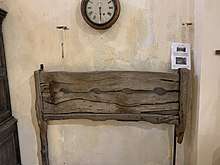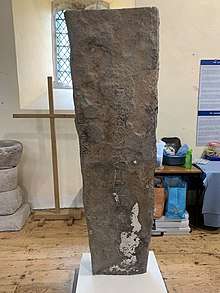Llywel
Llywel (![]()

Etymology
Llywel, occasionally referred to in texts as Llowel, is believed to be the name of a minor Welsh Saint. He is said to have been a disciple of Saint Teilo and Saint Dyfrig.
Church of St David

The Church of Saint David (Welsh: Eglwys Dewi Sant) in Llywel is said to have been dedicated to three saints: David, Darn (Paternus), and Teilo; and known as Llantrisant.[2] Its name was changed when it was granted to the Chapter of Saint David sometime between 1203[3] and 1229[4]
The church displays Perpendicular Gothic architecture. The grave of the writer and preacher David Owen (Brutus) is in the churchyard. As well holding a copy of the famous Llywel Stone, the Church holds the original Aberhydfer stone and old village stocks.




Llywel Stone
An Ogham stone named the Llywel Stone—because it was brought to the attention of the British Museum by the local vicar—, Lewis Price, was found at Pentre Poeth Farm. (Pentre Poeth farm no longer exists. It was in the region close to Cwm-cynwal and Pant y cadno just off the road from Bwysfa fawr near Trecastle on the way to Belfont farm Crai. There now is a large water tank on the place where the farm stood, which now is on Tircapel (Ty'r capel) farm ground. Tirchapel farm is believed to be named after an ancient chapel, Capel Illud, and it may be that the Llywel stone originally stood at the chapel site. The site is along the Roman road from Caerleon to Carmarthen, the Via Julia Montana). In 1878, the Llywel stone was acquired by the British Museum where it is on display. The inscription on the stone is 'MACCVTRENI + SALICIDVNI'.[5] A National Park booklet provides a drawing of the Llywel Stone and states that copies reside with Llywel Church and the Brecknock Museum, Brecon.[6]

References
- "Community population 2015". Retrieved 14 November 2015.
- http://www.cpat.demon.co.uk/projects/longer/churches/brecon/16903.htm Brecknockshire Churches Survey – Church of St David, Llywel
- http://www.cpat.demon.co.uk/projects/longer/churches/brecon/16903.htm Brecknockshire Churches Survey – Church of St David, Llywel
- http://www.terra-demetarum.org.uk/St_David/St_David.htm#FOOTNOTE James, Heather (accessed July 2008) The Cult of St. David—a study of dedication patterns in the medieval diocese of St Davids
- "standing stone / gate-post". British Museum - Collection online.
- "Archived copy". Archived from the original on 28 September 2011. Retrieved 24 July 2011.CS1 maint: archived copy as title (link)
